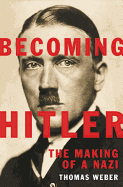
How did a shy aspiring artist become a genocidal dictator? This question has puzzled historians for seven decades, and its answer has ramifications for our understanding of radicalization in all its destructive forms. The exact process of Adolf Hitler's transformation from Viennese vagrant into hard right-wing German nationalist is more than a scholarly pursuit--it holds implications for the modern era, a fundamental lesson on how difficult socioeconomic circumstances and dangerous demagogues are cyclical disasters.
Becoming Hitler: The Making of a Nazi by Thomas Weber (Hitler's First War) chronicles the peculiarities of Hitler's transformative years. Weber, a history professor at the University of Aberdeen, argues that Hitler was not radicalized by his years in Vienna prior to World War I or even by the war itself, but rather began that process with Germany's defeat and by living in the revolutionary crucible of postwar Munich. Weber debunks Hitler's own mythologized past, which has been too often repeated by otherwise credible sources over the decades, to show that the future Fuhrer had malleable political persuasions even after the end of the war. Hitler was still serving in the army during the short-lived Bavarian Soviet Republic, neither fighting for nor against that extreme left-wing government. His convictions at this crucial moment, Weber argues, were for personal survival, an opportunism covered up by Hitler's later writing. His political ascendancy was an unlikely road that was paved as much by Hitler's burgeoning ambition as the city of Munich itself.
Becoming Hitler is both a scholarly achievement in the understanding of Hitler's life and a case study in radicalization. In the years 1918-1926, Weber finds the origin of the 20th-century's greatest evil, in detail thorough enough for history buffs while remaining accessible to wider audiences. --Tobias Mutter, freelance reviewer

